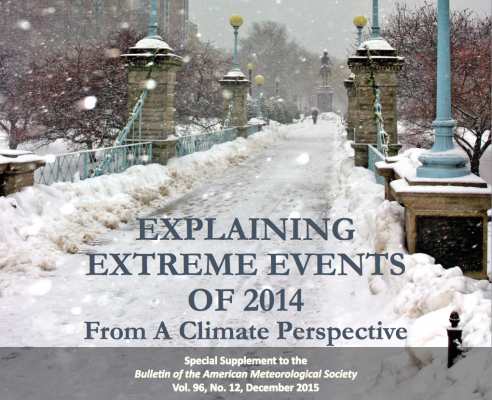Extreme event attribution is turning up the heat on climate change deniers

By Dr Anthony Horton
According to a recently published report by the American Meteorological Society (AMS) entitled “Explaining Extreme Events of 2014 From a Climate Perspective”, there is increasing evidence of human influence on climate changing the risk profile of events including the 2014 forest fires in California and snow storms in Nepal.
In terms of the California forest fires, the analysis included in the report showed that drought was in part responsible for the frequency of such events. Although the exact mechanism linking the fires and higher temperatures couldn’t be identified, the authors showed that global warming was likely to exacerbate both the risk and intensity of such events in future.
Analyses of heat events conducted in recent years continued to show the impact of human induced climate change, according to the AMS report. The report examined events in Argentina, Europe, China, Korea, Australia and both the northern Atlantic and Pacific Oceans and identified a climate change signal. Of the 22 other studies reviewed by the AMS, only one discussing heat events couldn’t detect a climate change signal.
The winter storms in North America in 2013/14 were less frequent than normal along the West Coast, and more frequent than normal in the region from central Canada to the Midwest United States. The storm activity was linked to atypical winds in the tropical Pacific and not to human induced climate change. The daily temperature variability over the Midwest and Eastern United States was found not to be influenced by human induced change. Seasonal extremes were also not unusual in the historic records. However, seasonal mean cold conditions in the greater Upper Midwest in 2013/14 are between 20 and 100 times less likely than in the 19th century as a result of long term higher temperatures.
Drought received significant attention in the report due to the complexity of meteorological, hydrological and societal drivers that play a part in the phenomenon. The results of analyses of drought events could vary greatly dependent on whether temperature or rainfall was examined. An analysis of the significantly lower rainfall associated with the severe drought in Southeastern Brazil could not find any human influence.
Two analyses of the drought in East Africa used different methods and reached different conclusions regarding the role of human induced climate change in drought intensity. While human induced climate change wasn’t linked to the Middle East and central-southwest Asia, lower rainfall as a result of climate change was linked to the drought in Syria.
Following an analysis of the tropical cyclone season in the vicinity of Hawaii, the AMS report concluded that the events were substantially more likely as a result of a combination of human induced factors and the El Nino Southern Oscillation (ENSO). The transition of Hurricane Gonzalo into a very strong extratropical storm that affected Europe was not found to have been influenced by human activity. The AMS report highlighted the importance of the limitations of models used to analyse such events, and in particular the extent to which they capture and process the relevant environmental data.
In addition, the authors of the report pointed out that a conclusion of no human influence may result from the chosen methodology not being able to detect it, or insufficient observations being used. Even though the report highlighted the importance of examining each analysis to maximise the effectiveness of attribution results, it was clear that with respect to investigations of the extreme weather around the world, they were increasingly likely to show a detectable human influence.
As a scientist who is interested in how methodologies evolve, become more rigorous and lead to results that are widely applicable in society, I was particularly engaged in the report’s discussion of future directions. The authors stated that event attribution could become more relevant to society by taking into account additional human induced drivers of extreme events above and beyond typical ones. The flooding in the Canadian prairies was reported to be more likely as a result of human impacts on rainfall and land use changes that influence the mechanisms of drainage.
The Jakarta floods may have also been influenced by land use change from urban development and land subsidence. These examples emphasize pathways by which human activity can increase the regional risk of extreme weather events. Information regarding the ways in which human activities can impact extreme events is critical for decision making.
In concluding the report, the authors highlighted that methodologies used in event attribution have come a long way such that they are now well established and could be used routinely. Being able to use such methodologies is this way can be a tremendous “shot in the arm” for scientists, insurance companies and corporations who are each looking at climate change risks and opportunities from different perspectives.
 About the author: Anthony Horton holds a PhD in Environmental Science, a Bachelor of Environmental Science with Honours and a Diploma of Carbon Management. He has a track record of delivering customised solutions in Academia, Government, the Mining Industry and Consulting based on the latest wisdom and his scientific background and experience in Climate/Atmospheric Science and Air Quality. Anthony’s work has been published in internationally recognised scientific journals and presented at international and national conferences, and he is currently on the Editorial Board of the Journal Nature Environment and Pollution Technology. Anthony also blogs on his own site, The Climate Change Guy.
About the author: Anthony Horton holds a PhD in Environmental Science, a Bachelor of Environmental Science with Honours and a Diploma of Carbon Management. He has a track record of delivering customised solutions in Academia, Government, the Mining Industry and Consulting based on the latest wisdom and his scientific background and experience in Climate/Atmospheric Science and Air Quality. Anthony’s work has been published in internationally recognised scientific journals and presented at international and national conferences, and he is currently on the Editorial Board of the Journal Nature Environment and Pollution Technology. Anthony also blogs on his own site, The Climate Change Guy.
Like what we do at The AIMN?
You’ll like it even more knowing that your donation will help us to keep up the good fight.
Chuck in a few bucks and see just how far it goes!
Your contribution to help with the running costs of this site will be gratefully accepted.
You can donate through PayPal or credit card via the button below, or donate via bank transfer: BSB: 062500; A/c no: 10495969









